A Look At Triple-GPU Performance And Multi-GPU Scaling, Part 1
by Ryan Smith on April 3, 2011 7:00 AM ESTCiv V, Battlefield, STALKER, and DIRT 2
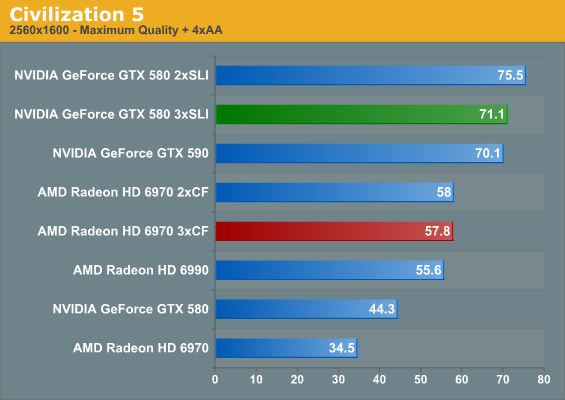
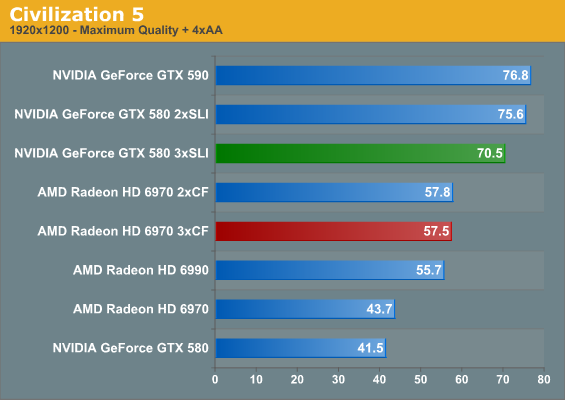
Civilization V continues to be the oddball among our benchmarks. Having started out as a title with low framerates and poor multi-GPU scaling, in recent months AMD and NVIDIA have rectified this some. As a result it’s now possible to crack 60fps at 2560 with a pair of high-end GPUs, albeit with some difficulty. In our experience Civ V is a hybrid bottlenecked game – we have every reason to believe it’s bottlenecked by the CPU at certain points, but the disparity between NVIDIA and AMD’s performance indicates there’s a big difference in how the two are settings things up under the hood.
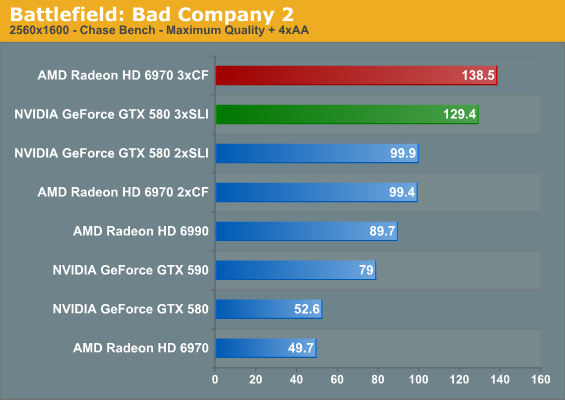
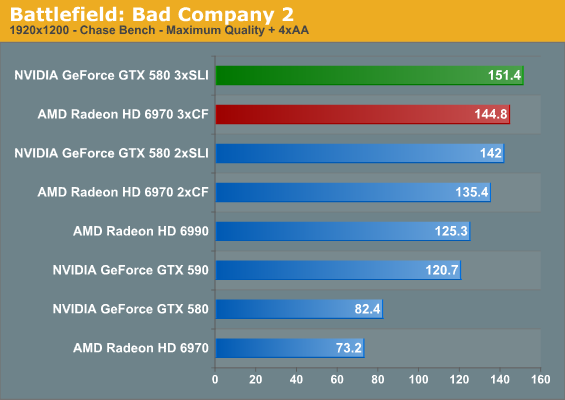
When we started using Bad Company 2 a year ago, it was actually a rather demanding benchmark; anything above 60fps at 2560 required SLI/CF. Today that’s still true, but at 52fps the GTX 580 comes close to closing that gap. On the flip side two GPUs can send scores quite a distance up, and three GPUs will push that over 120fps. Now if we could just get a 120Hz 2560 monitor…
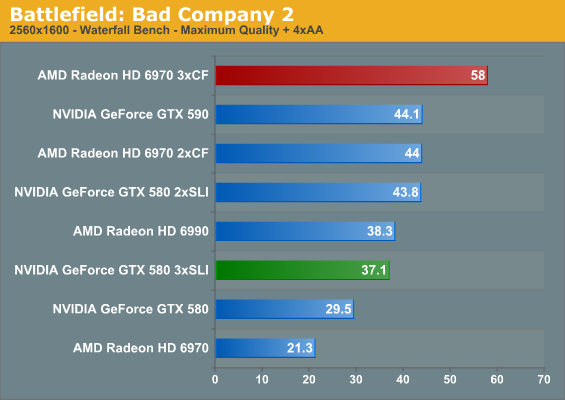
The Bad Company 2 Waterfall benchmark is our other minimum framerate benchmark, as it provides very consistent results. NVIDIA normally does well here with one GPU, but with two GPUs the gap closes to the point where NVIDIA may be CPU limited as indicated by our 580SLI/590 scores. At three GPUs AMD falls just short of a 60fps minimum, while the triple GTX 580 setup drops in performance. This would indicate uneven performance scaling for NVIDIA with three GPUs.
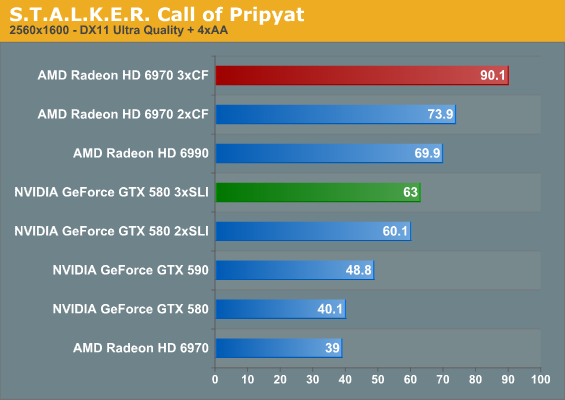
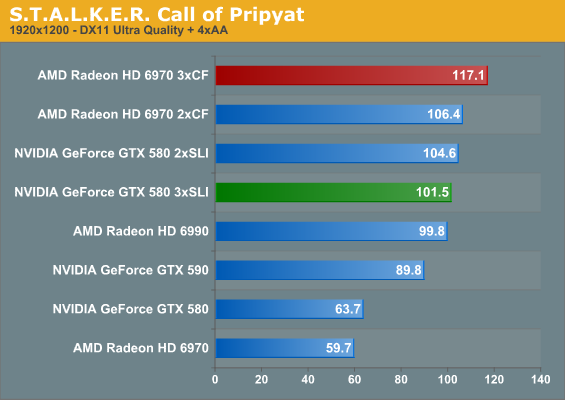
STALKER is another title that is both shader heavy and potentially VRAM-intensive. When moving from 1GB cards to 2GB cards we’ve seen the average framerate climb a respectable amount, which may be why AMD does so well here with multiple GPUs given the 512MB advantage in VRAM. With three GPUs the GTX 580 can crack 60fps, but the 6970 can clear 90fps.
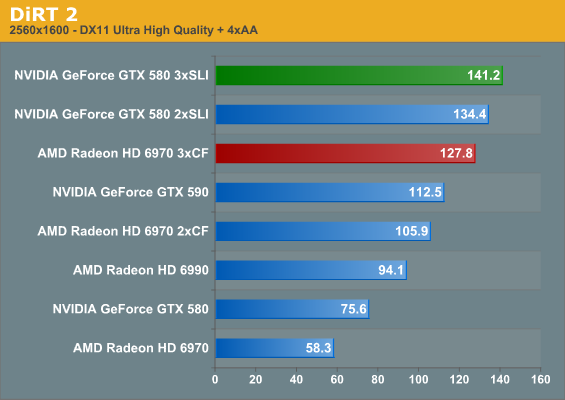
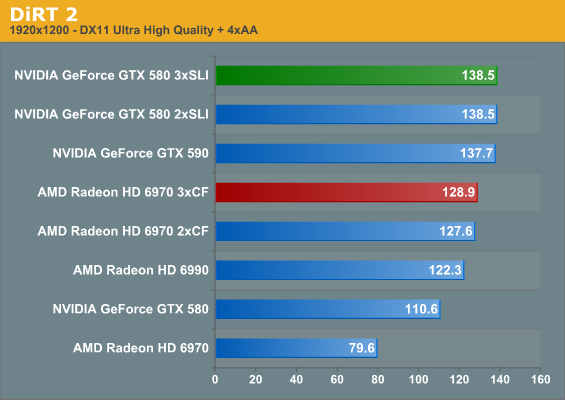
We’ve seen DiRT 2 become CPU limited with two GPUs at 1920, so it shouldn’t come as a surprise that with three GPUs a similar thing happens at 2560. Although we can never be 100% sure that we’re CPU limited versus just seeing poor scaling, the fact that our framerates top out at only a few FPS above our top 1920 scores is a solid sign of this.
| Radeon HD 6970 | GeForce GTX 580 | |||||
| GPUs | 1->2 | 2->3 | 1->3 | 1->2 | 2->3 | 1->3 |
| Civilization V | 168% | 99% | 167% | 170% | 95% | 160% |
| Battlefield: BC2 Chase | 200% | 139% | 278% | 189% | 129% | 246% |
| Battlefield: BC2 Water | 206% | 131% | 272% | 148% | 85% | 125% |
| STALKER: CoP | 189% | 121% | 231% | 149% | 104% | 157% |
| DiRT 2 | 181% | 120% | 219% | 177% | 105% | 186% |
So what does multi-GPU scaling look like in this batch of games? The numbers favor AMD at this point, particularly thanks to STALKER. Throwing out a CPU limited DIRT 2, and the average FPS for an AMD card moving from one GPU to two GPUs is 185%; NVIDIA’s gains under the same circumstances are only 169%.
For the case of two GPUs, AMD’s worst showing is Civilization V at 168%, while for NVIDIA it’s STALKER at %149. In the case of Civilization V the close gains to NVIDIA (168% vs. 170%) hides the fact that the GTX 580 already starts out at a much better framerate, so while the gains are similar the final performance is not. STALKER meanwhile presents us with an interesting case where the GTX 580 and Radeon HD 6970 start out close and end up far apart; AMD has the scaling and performance advantage thanks to NVIDIA’s limited performance gains here.
As for scaling with three GPUs, as was the case with two GPUs the results are in AMD’s favor. We still see some weak scaling at times – or none as in the case of Civilization V – but AMD’s average gain of 120% over a dual-GPU configuration isn’t too bad. NVIDIA’s average gains are basically only half AMD’s though at 110%, owing to an even larger performance loss in Civilization V, and almost no gain in STALKER. Battlefield: Bad Company 2 is the only title that NVIDIA sees significant gains in, and while the specter of CPU limits always looms overhead, I’m not sure what’s going on in STALKER for NVIDIA; perhaps we’re looking at the limits of 1.5GB of VRAM?
Looking at minimum framerates though the Battlefield: Bad Company 2, the situation is strongly in AMD’s favor for both two and three GPUs, as AMD scales practically perfectly with two GPUs and relatively well with three GPUs. I strongly believe this has more to do with the game than the technology, but at the end of the day NVIDIA’s poor triple-GPU scaling under this benchmark really puts a damper on things.










97 Comments
View All Comments
marc1000 - Monday, April 4, 2011 - link
Ryan, if at all possible, please include a reference card for the "low-point" of performance. We rarely see good tests with mainstream cards, only the top tier ones.So if you can, please include a radeon-5770 or GTX460 - 2 of these cards should have the same performance as one of the big ones, so it would be nice to see how well they work by now.
Ryan Smith - Wednesday, April 6, 2011 - link
These charts were specifically cut short as the focus was on multi-GPU configurations, and so that I could fit more charts on a page. The tests are the same tests we always run, so Bench or a recent article ( http://www.anandtech.com/show/4260/amds-radeon-hd-... ) is always your best buddy.Arbie - Monday, April 4, 2011 - link
Looking at your results, it seems that at least 99.9% of gaming enthusiasts would need nothing more than a single HD 6970. Never mind the wider population of PC-centric folk who read Anandtech.More importantly, this isn't going to change for several years. PC game graphics are now bounded by console capabilities, and those advance only glacially. In general, gamers with an HD 6850 (not a typo) or better will have no compelling reason to upgrade until around 2014! I'm very sad to say that, but think it's true.
Of course there is some technical interest in how many more FPS this or that competing architecture can manage, but most of that is a holdover from previous years when these things actually mattered on your desktop. I'm not going to spend $900 to pack two giant cooling and noise problems into my PC for no perceptible benefit. Nor will anyone else, statistically speaking.
The harm in producing such reports is that it spreads the idea that these multi-board configurations still matter. So every high-end motherboard that I consider for my next build packs in slots for two or even three graphics boards, and an NF-200 chip to make sure that third card (!) gets enough bandwidth. The mobos are bigger, hotter, and more expensive than they need to be, and often leave out stuff I would much rather have. Look at the Gigabyte P67A-UD7, for example. Full accommodation for pointless graphics overkill (praised in reviews), but *no* chassis fan controls (too mundane for reviewers to mention).
I'd rather see Anandtech spend time on detailed high-end motherboard comparisons (eg. Asus Maximus IV vs. others) and components that can actually improve my enthusiast PC experience. Sadly, right now that seems to be limited to SSDs and you already try hard on those. Are we reduced to... fan controllers?
Thanks,
Arbie
erple2 - Tuesday, April 5, 2011 - link
There are still several games that are not Console Ports (or destined to be ported to a console) that are still interesting to read about and subsequently benchmark. People will continue to complain that PC Gaming has been a steady stream of Console Ports, just like they have been since the PSX came out in late '95. The reality is that PC Gaming isn't dead, and probably won't die for a long while. While it may be true that EA and company generate most of their revenue from lame console rehash after lame console rehash, and therefore focus almost single-mindedly on that endeavor, there are plenty of other game publishers that aren't following that trend, thereby continuing to make PC Gaming relevant.The last several tests I've seen of Motherboard reviews has more or less convinced me that they just don't matter at all any more. Most (if not all) motherboards of a given chipset don't offer anything performance wise over other competing motherboards.
There are nice features here and there (Additional Fan Headers, more USB ports, more SATA Ports), but on the whole, there's nothing significant to differentiate one Motherboard from another, at least from a performance perspective.
789427 - Monday, April 4, 2011 - link
I would have thought that someone would pay attention to if throttling was occurring on any of the cards due to thermal overload.The reason is that due to differences in ventilation in the case, layout and physical card package, you'll have throttling at different times.
e.g. if the room was at a stinking hot 50C, the more aggressive the throttling,the greater the disadvantage to the card.
Conversely, operating the cards at -5C would provide a huge advantage to the card with the worst heat/fan efficiency ratio.
cb
TareX - Monday, April 4, 2011 - link
I'm starting to think it's really getting less and less compelling to be a PC gamer, with all the good games coming out for consoles exclusively.Thank goodness for Arkham Asylum.
Golgatha - Monday, April 4, 2011 - link
I'd like to see some power, heat, and PPD numbers for running Folding@Home on all these GPUs.Ryan Smith - Monday, April 4, 2011 - link
The last time I checked, F@H did not having a modern Radeon client. If they did we'd be using it much more frequently.karndog - Monday, April 4, 2011 - link
Cmon man, you have an enthusiast rig with $1000 worth of video cards yet you use a stock i7 at 3.3ghz??"As we normally turn to Crysis as our first benchmark it ends up being quite amusing when we have a rather exact tie on our hands."
Ummm probably because your CPU limited! Update to even a 2500k at 4.5ghz and i bet you'll see the Crossfire setup pull away from the SLI.
karndog - Monday, April 4, 2011 - link
Not trying to make fun of your test rig, if that's all you have access too. Im just saying that people who are thinking about buying the Tri SLI / Xfire video card setups reviewed here arent running their CPU at stock clock speeds, especially such low ones, which skew the results shown here.